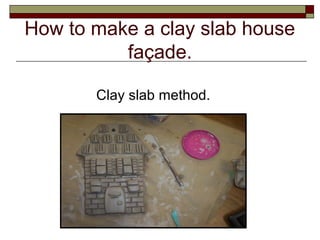How to make a clay slab house facade
- 1. How to make a clay slab house façade. Clay slab method.
- 2. Step 1: Cut out a paper pattern for your house and for your roof. Your house cannot be any bigger than 5x8 inches when the roof is attached!
- 3. Make sure your patterns don’t measure any bigger than 5 x8 inches when they’re put together.
- 4. Step 2: Put pattern(s) on clay slab.
- 5. Step 3: Use clay tool to cut around each pattern. Press firmly to cut through the clay.
- 6. Step 4: Use a clay tool to score the two edges you are attaching together.
- 7. Step 5: Add clay slip to the edges you are attaching together.
- 8. Step 6 : Use clay slip to permanently attach the roof to the house and strengthen the seam.
- 9. Step 7: Flip it over and secure the back with clay slip as well.
- 10. Step 8: Fill in with extra clay if there are any gaps.
- 11. Step 9: Use a sponge to smooth out the surface so you can’t see where the roof was attached.
- 12. Step 10: Use your clay tool to cut windows, shutters, shingles, and a door from your extra clay.
- 13. You may want to cut many of the same shapes to create a pattern.
- 14. Remember… Whenever you want to permanently add something to your house you’ll need to score it and slip it!!!
- 15. You can add doors, windows, shutters, bricks, and shingles. Use your clay tool to blend the clay together to make sure everything is firmly attached.
- 16. Adding Texture Use a clay tool to add texture to the roof, shutters, etc.
- 17. Use a round clay tool to press a hole through the top of the house so you can hang it once it is kiln fired and glazed.
- 18. Try creating a variety of textures to embellish your artwork.
- 19. If you are finished for the day but want to work on it again, slide your house into a zip-lock bag so it stays soft. Be sure to seal it!
- 20. Don’t forget to put your name on the bag!
- 21. Finishing Up •Put your clay scraps into the bag too. •Seal the bag. •Carefully place your bag on the shelf. •Clean your work area before you leave. •If you are totally finished you can let it dry outside the bag.
- 22. Once it’s had time to dry it’s ready for bisque firing! (Bisque firing is necessary to gain structural strength).
- 24. Vocabulary Words • architect: a person who designs and makes plans for buildings. • slip: muddy, liquid clay used to attach two pieces. • score: to make marks on the clay to attach two pieces. • slab: a flat, rolled out piece of clay. • coil: a rope of clay, rolled out with your fingers. • kiln: used to heat the clay to make it permanent. It gets over 2000 degrees! • firing: heating the clay to make it permanent. • bisque fire: firing at a low temperature to gain structural strength. Prior to glaze application. • sculpture: a three-dimensional work of art. • leather hard: clay in a semi-dry state, similar to leather.























